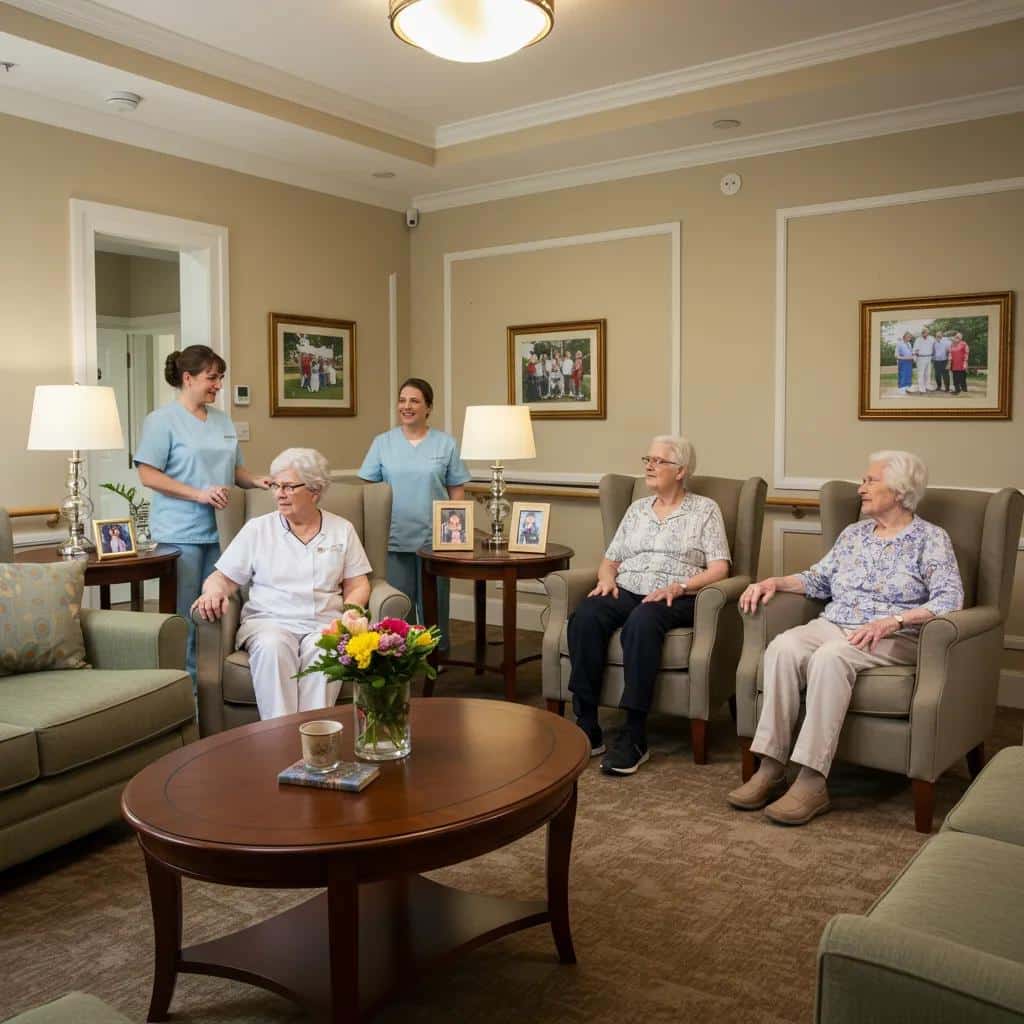Find exceptional Alzheimer's care services in Ann Arbor that ensure safety and support. Tailored solutions foster dignity and quality of life for loved ones.

A Professional Guide to Memory Care Homes in Saline, MI
A Professional Guide to Memory Care Homes in Saline, MI

Comparing Alzheimer’s Care Options in Saline: Finding the Best Memory Care Facilities and Costs for Your Loved One
Finding the right memory care homes in Saline, MI, can feel overwhelming when Alzheimer’s disease demands specialized attention and a supportive environment. Families need clear comparisons of facility models, individualized care approaches, cost transparency, safety features, and local resources to make informed decisions. This article maps out the key types of memory care options in Saline—ranging from large assisted living units to intimate residential homes and in-home dementia care—then examines how Memory Lane Assisted Living’s personalized offerings, pricing, and safety innovations compare. You will learn how caregiver ratios, therapeutic activities, and home-like settings influence well-being, how cost structures align across Saline, Ann Arbor, and Ypsilanti, and which questions to ask during facility tours. By weaving evidence of specialized training, technology integration, and family support resources into each section, this guide serves as a trusted roadmap for navigating memory care choices in October 2025 and beyond.
What Are the Key Types of Memory Care Options Available in Saline, MI?
Memory care is a specialized branch of assisted living tailored to meet the needs of seniors with Alzheimer’s disease and other forms of dementia. It provides structured daily routines, secure environments, and 24-hour supervision to support cognitive, emotional, and physical health. In Saline, MI, three primary models dominate local offerings: large assisted living facilities with dedicated memory wings, residential memory care homes in small-group settings, and personalized in-home dementia care. Each model balances safety, social engagement, and individualized support in different ways, helping families align preferences for community size, cost, and therapeutic programming.
This comparison illustrates how community scale and service focus shift from broad campus resources in larger facilities to highly personalized care in small homes and private residences. Understanding these distinctions prepares families to dive deeper into each option’s defining characteristics.
What Defines Large Assisted Living Facilities with Memory Care Units?
Large assisted living facilities with memory care units offer a campus-style environment designed for seniors requiring cognitive support. These communities typically group residents into neighborhoods or wings dedicated to memory care, each featuring secure entry and exit controls, communal dining rooms, and programmed activities designed for cognitive stimulation. By embedding dementia-focused social events and medication management within a larger senior living community, these facilities deliver the benefit of diverse amenities—such as fitness centers, beauty salons, and organized outings—while maintaining specialized protocols for wandering prevention and behavioral support.
Families often choose large assisted living memory care units for their extensive on-site resources, licensed nursing oversight, and diverse activity calendars. However, the higher resident count can lead to lower caregiver-to-resident ratios (often 1:8 or 1:10), which may limit individualized attention. As Alzheimer’s disease progresses, some residents benefit more from smaller group sizes that foster deeper relationships and consistency in daily routines. This dynamic draws many families to explore alternative options in Saline.
Staffing Ratios in Memory Care Units vs. Assisted Living
Second, we compared resident-to-staff ratios for NHs to ALCs. Third, we compared the overall resident-to-staff ratios with the resident-to-staff ratios in the MCU to understand how staffing levels differ across different care settings.
Staffing patterns in nursing homes, assisted living communities, and memory care units: variation across shifts, JR Bowblis, 2024
How Do Residential Memory Care Homes Like Memory Lane Differ?
Residential memory care homes such as those provided by Memory Lane Assisted Living redefine individualized dementia support by combining a home-like addressable space with professional 24-hour care. Each of Memory Lane’s three six-bedroom homes in the Saline, Ypsilanti, and Ann Arbor areas ensures that personalized care plans address the specific needs of Alzheimer’s, Lewy Body, frontotemporal dementia, and other conditions. Caregivers know each resident’s preferences, habits, and triggers, promoting comfort and reducing anxiety through familiar environments and predictable schedules.
Key advantages of residential memory care homes:
- High Caregiver Ratio – Typically one caregiver for every three to four residents to provide more consistent supervision.
- Family-Style Living – Shared kitchens, living rooms, and outdoor areas recreate the familiarity of home.
- All-Inclusive Structure – Comprehensive pricing covers meals, hygiene assistance, medication oversight, and enrichment activities.
This intimate model enhances well-being by fostering meaningful connections and rapid response to behavioral changes, creating a secure but warm setting that often leads to improved mood and reduced agitation among seniors with dementia.
What Are the Benefits and Drawbacks of In-Home Dementia Care?
In-home dementia care brings personalized support directly into a senior’s residence, offering familiarity and routine consistency that ease transitions for individuals with cognitive decline. Professional caregivers deliver assistance with activities of daily living, meal preparation, medication reminders, and companionship. Scheduling can range from a few hours per day to full-time live-in services, allowing families to tailor support intensity and budget accordingly.
Advantages of in-home dementia care:
- Enables seniors to remain in familiar surroundings, reducing confusion and agitation.
- Provides true one-on-one focus, adapting to individual behavioral fluctuations in real time.
- Offers flexible hours and continuity with a consistent caregiver or team.
Potential drawbacks include:
- Limited social interaction compared to community-based programs.
- Higher hourly costs for sustained one-on-one attention.
- Family coordination challenges for scheduling, oversight, and emergency responsiveness.
While in-home care excels in personalization and routine preservation, families often weigh the social and cost benefits of residential memory care options when long-term support needs intensify.
In-Home Respite Care for Dementia Caregivers: Effectiveness and Cost
Frequent hospitalization and permanent nursing home placement not only affect the well-being of persons with dementia, but also place great financial strain on society. Therefore, it is important to create effective strategies to support informal caregivers so that they can continue to perform their demanding role. Preliminary qualitative evidence suggests that community-based respite services can actually be important for caregivers, and that the level of evidence should be further established in terms of effectiveness.
Effectiveness and cost-effectiveness of an in-home respite care program in supporting informal caregivers of people with dementia: design of a comparative study, K Putman, 2016
How Does Memory Lane Assisted Living Provide Specialized Care for Alzheimer’s and Dementia?
Memory Lane Assisted Living specializes in residential memory care homes that integrate personalized plans, enriched environments, and caregiver expertise. A tailored approach begins with a comprehensive assessment of cognitive, physical, and emotional needs, leading to custom care plans that evolve with each resident’s condition. By focusing on a high caregiver-to-resident ratio, structured but adaptable daily routines, and meaningful activities, Memory Lane promotes safety, social engagement, and dignity for residents coping with Alzheimer’s disease and other forms of dementia.
Each of Memory Lane’s homes fosters a sense of belonging and routine consistency. Within this framework, specialized care elements such as personalized meal preferences, memory boxes to support orientation, and small-group recreational programs ensure that every day aligns with the strengths and challenges of each individual. This model not only supports core Activities of Daily Living but also enriches life through familiar music, art classes, and gentle exercise.
What Personalized Dementia Care Plans Does Memory Lane Offer?
Memory Lane’s personalized dementia care plans begin with an initial intake meeting to document medical history, cognitive abilities, interests, and life story details. Care plans typically include:
- Daily Routine Design – Customized schedules that align waking, dining, and rest periods with individual habits.
- Safety Protocols – Tailored wandering prevention strategies based on mobility levels and memory cues.
- Therapeutic Engagement – One-on-one and small-group activities that address cognitive stimulation, reminiscence therapy, and emotional support.
By reassessing care plans quarterly or upon condition changes, Memory Lane ensures that each resident receives evolving support that targets symptom progression and maximizes quality of life.
Why Is a High Caregiver-to-Resident Ratio Important for Memory Care?
A high caregiver-to-resident ratio directly influences individualized attention, safety, and emotional well-being. Memory Lane’s ratio of roughly one caregiver per three to four residents enhances:
- Continuous Monitoring – Immediate response to wandering attempts, falls, or agitation episodes.
- Emotional Connection – Stronger relationships foster a sense of security and trust essential for residents with Alzheimer’s disease.
- Adaptive Care – Caregivers can adjust support moments by moment, from assisting with dressing to redirecting anxious behaviors.
Facilities with lower ratios often struggle to anticipate resident needs and respond promptly, whereas Memory Lane’s model supports both proactive care and richer social bonds.
How Does a Home-Like Environment Improve Resident Well-Being?
A home-like environment reduces stress and confusion by replicating familiar sights, routines, and social cues that align with long-term memories. Memory Lane’s residential homes feature:
- Comfortable common areas furnished like living rooms.
- Personalized bedrooms with memory aids such as photo collages.
- Secure gardens and patios that encourage safe outdoor connection.
This comforting setting improves orientation, lowers anxiety, and fosters social interactions among small resident groups. By blending professional care with domestic familiarity, Memory Lane nurtures well-being in ways that institutional atmospheres often cannot.
What Specialized Dementia Training and Therapeutic Activities Are Provided?
Memory Lane’s caregivers receive ongoing training in dementia best practices, including:
- Validation Therapy – Techniques that acknowledge and support resident emotions.
- Redirection Strategies – Methods to guide residents away from distress triggers.
- Activity Programming – Structured sessions in art, music, gardening, and gentle exercise tailored to cognitive levels.
Residents attend daily therapeutic activities that blend sensory stimulation with social engagement. This holistic approach supports preserved abilities, slows cognitive decline, and builds a strong community within each six-bedroom home.
What Are the Average Alzheimer’s Care Costs in Saline, MI, and How Does Memory Lane’s Pricing Compare?
Understanding memory care costs is essential for budgeting and comparing options in Saline, Ann Arbor, and Ypsilanti. As of late 2025, average monthly rates for memory care in Saline range around $5,200, with higher-end estimates nearing $9,980 depending on amenities and staffing levels. Ann Arbor averages approximately $8,100 per month, while Ypsilanti hovers near $6,000. These variations reflect facility size, level of medical oversight, and amenity packages.
While direct costs for home care can appear higher on an hourly basis, the overall financial picture can be complex when considering indirect costs and societal impact.
Dementia Care Costs: Home vs. Institutional Services in Taiwan
However, the indirect cost was significantly higher in home care than institutional care. However, compared with previous studies, the cost estimations in this study were more clear and comprehensive, covering direct and indirect costs for both home and institutional care.
Dementia care costs and the patient’s quality of life (QoL) in Taiwan: home versus institutional care services, LK Chen, 2010
What Is Included in Memory Lane’s All-Inclusive Pricing Model?
Memory Lane’s transparent all-inclusive pricing covers:
- Private or semi-private bedrooms with personalized décor.
- Three nutritious meals and snacks tailored to dietary needs.
- 24-hour licensed caregiving staff for hygiene, mobility, and medication support.
- Daily therapeutic activities and social programming.
- Housekeeping, laundry, and maintenance.
- Secure environment infrastructure and wandering prevention systems.
Families benefit from predictable budgeting and no hidden fees, allowing them to focus on their loved one’s care without financial surprises.
How Do Saline, Ann Arbor, and Ypsilanti Memory Care Costs Compare?
Cost differences across Saline, Ann Arbor, and Ypsilanti reflect local market demand, facility size, and service offerings. Ann Arbor’s higher average stems from robust academic-medical collaborations and premium amenities, while Ypsilanti’s slightly lower rates indicate smaller-scale providers and less competitive pricing. Memory Lane’s uniform rate across all three locations emphasizes consistency in specialized memory care quality and caregiver expertise, regardless of city.
What Payment Assistance Options Are Available for Memory Care?
Families can explore multiple financial support avenues:
- Veterans Benefits – Aid and Attendance pension for qualifying veterans and spouses.
- Long-Term Care Insurance – Policies that cover memory care based on benefit triggers.
- Medicaid Waivers – State programs that subsidize home- and community-based services for eligible seniors.
- Tax Credits and Deductions – Medical expense deductions when memory care costs exceed income thresholds.
By coordinating with financial advisors and local aging agencies, families can optimize payment plans and ease the burden of memory care expenses.
What Safety, Security, and Technology Features Enhance Memory Care in Saline Facilities?
Memory care residents require environments engineered for safety, security, and meaningful engagement. Facilities in Saline implement perimeter alarms, monitored door locks, and unobtrusive emergency call systems to prevent wandering and support rapid response. Advanced monitoring technology, from motion sensors to wearable alert devices, creates layers of protection without stifling resident autonomy.
How Do Facilities Prevent Wandering and Ensure Resident Safety?
Preventing wandering involves secure entry-exit points, discreet alarms on doors, and staff trained to recognize early signs of exit attempts. Common design elements include:
- Locked Neighborhoods – Controlled access that allows safe movement inside secure boundaries.
- Visual Cues – Color-coded flooring and signage that assist orientation.
- Behavioral Monitoring – Regular wellness checks and personalized wandering prevention protocols tailored to each resident’s mobility and memory patterns.
These measures reduce elopement risks, fostering peace of mind for families and caregivers.
What Technology Is Used for Monitoring and Engagement at Memory Lane?
Memory Lane integrates unobtrusive technology to balance safety and interaction:
- Motion Sensors in hallways and common areas for real-time location alerts.
- Wearable Pendants with one-touch emergency call buttons linked to central nurse stations.
- Digital Activity Boards that display daily schedules and personalized reminders.
- Tablet-Based Cognitive Games that engage residents in brain-stimulating exercises under caregiver supervision.
By adopting these tools, Memory Lane enhances security while promoting engagement, socialization, and cognitive health.
How Can Families Choose the Right Memory Care Facility in Saline?
Selecting a memory care home requires careful evaluation of care philosophy, staffing levels, environment, and costs. Families should prioritize transparent communication, opportunities for personalized routines, and evidence of ongoing staff training. A structured comparison helps align loved ones’ cognitive needs with the specialty services and design features of each facility model.
What Are the Most Important Factors to Consider When Comparing Facilities?
Key decision criteria include:
- Caregiver-to-Resident Ratio – Higher ratios allow more personalized interaction.
- Environment Design – Home-like vs. institutional style influences comfort and orientation.
- Specialized Programming – Frequency and variety of dementia-focused activities.
- Safety Protocols – Wandering prevention, emergency response, and supervision.
- Cost Transparency – Clarity of all-inclusive rates, extra fees, and payment options.
By ranking these factors by personal priority, families can create a structured site-visit checklist.
How Does Memory Lane’s Small-Group Model Benefit Residents Compared to Larger Facilities?
Memory Lane’s small-group residential homes foster deeper connections, consistent caregiver assignments, and predictable daily rhythms that often reduce agitation and improve functional independence. In contrast to larger campuses where staff rotation may vary, each Memory Lane home offers stable caregiver teams who build trust and quickly adapt interventions to subtle changes in resident behavior. This continuity promotes emotional security and enhances resident engagement in therapeutic activities.
What Questions Should Families Ask During Facility Tours?
- How many residents share each caregiver?
- What is the process for updating individualized care plans?
- Which training certifications do staff members hold for dementia care?
- How are meals, activities, and routines adapted for Alzheimer’s stages?
- Can families observe or participate in a therapeutic activity session?
What Support Resources Are Available for Families and Caregivers of Dementia Patients in Saline?
Navigating Alzheimer’s care extends beyond facility selection to include educational, emotional, and peer support for families. Local and online resources provide guidance on disease progression, caregiving strategies, and community connections.
Where Can Caregivers Find Support Groups and Educational Resources?
- Community-based Alzheimer’s Association chapters offering monthly support meetings.
- Regional senior centers hosting dementia education seminars.
- Online forums and webinars led by geriatric specialists.
- Local health system outreach programs that provide care planning workshops.
How Can Families Navigate the Transition to Memory Care?
- Gradually introducing short visits to the new community.
- Sharing personal items and photos to foster familiarity.
- Maintaining established routines for meals and activities.
- Encouraging open communication with care teams to address anxieties.
- Seeking family counseling services to process emotional shifts.
A step-by-step transition plan anchored in consistent routines and support resources eases adjustment for both residents and loved ones.
What Do Families Say About Memory Lane Assisted Living?
Feedback from families highlights Memory Lane’s commitment to individualized attention, compassionate staff interactions, and transparent partnership in dementia journeys. Testimonials often underscore how small home environments foster genuine relationships and peace of mind.
What Are Common Themes in Family Testimonials and Success Stories?
Families consistently praise:
- The rapid rapport between caregivers and residents that nurtures trust.
- Visible reductions in loved-one anxiety and improved mood from personalized activities.
- Clarity of communication regarding care plan adjustments and health updates.
- The sense of community among six-resident homes that mirrors family life.
How Does Memory Lane Build Trust and Peace of Mind for Families?
Trust emerges from proactive care communication, easy access to care teams, and consistent observation of well-being metrics. Families report relief knowing their loved ones experience stability through familiar routines, engaging activities, and caregivers who know personal histories. This integrated approach generates confidence that Alzheimer’s and dementia challenges are met with expertise, empathy, and genuine partnership.
As you compare memory care homes in Saline, MI, keep these insights, comparisons, and family perspectives in mind to find the environment and care model best suited to your loved one’s needs.
Frequently Asked Questions
What should families consider when touring memory care facilities?
When touring memory care facilities, families should focus on several key factors. These include the caregiver-to-resident ratio, which impacts the level of personalized attention each resident receives. Additionally, observe the environment design—whether it feels home-like or institutional—as this can affect comfort and orientation. Inquire about specialized programming and safety protocols, such as wandering prevention measures. Lastly, ensure cost transparency by asking about all-inclusive rates and any potential hidden fees to avoid surprises later on.
How can families assess the quality of care in memory care facilities?
To assess the quality of care in memory care facilities, families should look for evidence of staff training and certifications in dementia care. Observing staff interactions with residents can provide insights into the level of compassion and engagement. Additionally, inquire about the frequency and variety of therapeutic activities offered, as well as how care plans are tailored to individual needs. Reviews and testimonials from other families can also offer valuable perspectives on the facility’s overall care quality and environment.
What role do family members play in the care of their loved ones in memory care?
Family members play a crucial role in the care of their loved ones in memory care settings. They can provide valuable insights into the resident’s history, preferences, and triggers, which help caregivers tailor care plans effectively. Regular communication with the care team is essential for staying informed about changes in the resident’s condition and care needs. Additionally, family involvement in activities and visits can enhance the emotional well-being of residents, fostering a sense of connection and support.
What are the signs that a memory care facility is a good fit for a loved one?
Signs that a memory care facility is a good fit for a loved one include a welcoming atmosphere that feels comfortable and safe. Positive interactions between staff and residents, along with a high caregiver-to-resident ratio, indicate personalized attention. Look for facilities that offer tailored activities and programs that align with the resident’s interests and cognitive abilities. Additionally, transparent communication from staff regarding care plans and family involvement opportunities can signal a supportive environment for both residents and their families.
How can families prepare for the transition to memory care?
Preparing for the transition to memory care involves several steps to ease the adjustment for both residents and families. Start by gradually introducing short visits to the new facility to familiarize the loved one with the environment. Sharing personal items, such as photos or familiar belongings, can help create a sense of comfort. Maintaining established routines for meals and activities is also beneficial. Open communication with care teams about any concerns or anxieties can further support a smoother transition.
What types of activities are beneficial for residents in memory care?
Beneficial activities for residents in memory care include those that promote cognitive engagement, social interaction, and emotional well-being. Activities such as art and music therapy, gardening, and reminiscence therapy can stimulate memories and encourage participation. Gentle exercise programs tailored to residents’ abilities help maintain physical health. Additionally, small-group activities foster social connections, while one-on-one interactions with caregivers provide personalized attention and support, enhancing the overall quality of life for residents.
Conclusion
Choosing the right memory care facility in Saline can significantly enhance the quality of life for your loved one with Alzheimer’s or dementia. By understanding the various care options, costs, and personalized approaches available, families can make informed decisions that prioritize safety and emotional well-being. Memory Lane Assisted Living stands out with its high caregiver-to-resident ratio and home-like environment, ensuring tailored support for each resident. Explore our offerings today to find the best fit for your family’s needs.


